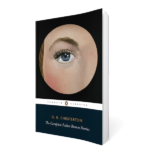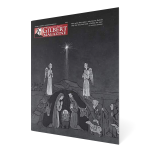The Mask of Midas
In his 1999 mystery novel, Irish Tenure, Ralph McInerny, in addition to creating a character who insults a glossy magazine devoted to G.K. Chesterton, manages to stage a murder connected to the discovery of a lost Father Brown manuscript at Notre Dame. It’s all very amusing. But sometimes truth is plainer than fiction. There actually was a lost—and found—Father Brown manuscript, and when it was finally published, almost no one noticed. This is not amusing. It is tragic.
The Mask of Midas is the only Father Brown story published as a book. It was the last Father Brown story Chesterton ever wrote and was never published in his lifetime. Thanks to the efforts of Geir Hasnes, it was published in 1991 in Norway, a beautiful limited edition of 1000 copies, with original illustrations by Noralf Husby, an introduction by Geir, and a Father Brown bibliography by John Peterson.
A note on the manuscript in Dorothy Collins’ hand indicates that this was to be second story in a new series featuring the beloved priest-detective, The Vampire of the Village, presumably being the first. We get a glimpse of what might have been. Perhaps the last collection would have been called The Myth of Father Brown.
In his introduction, Geir refers to the rumor that the last Father Brown story was actually rejected by the mystery magazines, but Dorothy Collins didn’t have the heart to break the news to Chesterton. There is no evidence for this. None. Perhaps the reason it arose is that critics
have not been kind to this last Father Brown tale, finding the narrative a little hard to follow, with too little explanation on the one hand and too many plot twists on the other. But critics tend to miss the obvious, which is what makes them so endearing. Their analysis of the story could also serve as a precise description of the world of finance, which is what this story is really about. It is fitting that it at first seems to be about one sort of crime, but ends up being another completely different sort of crime, the hardest kind to discover, since it happens largely on paper that no one gets to see, and even seeing it does not mean understanding it. Father Brown himself laments that crimes have grown more complicated (especially when they involve rich bankers), and he longs nostalgically for the good old days when there were simple murders involving switching severed heads.
For the rest, it is classic Father Brown. His first appearance is typically undramatic, somewhere in the middle of the sixth paragraph: “The third man was stumpy and sturdy, with a round black clerical hat and a round black clerical figure, as well as a round face which had looked up to that moment a little sleepy. . .” He makes his quiet observations, irritates his companions with cryptic paradoxes, offers some moral reflections, and solves the crime. Best of all, Chesterton concludes by seating him comfortably in a pub and actually comparing him with Pickwick, bringing together his favorite book with his most famous fictional character. A warm good-bye.
Detective fiction fans should have been ecstatic at this publication. But the book appeared during a conspiracy of silence regarding Chesterton. But the Chestertonians in the catacombs rejoiced, and from now on, all “Complete” Father Brown collections will include “The Mask of Midas.”


